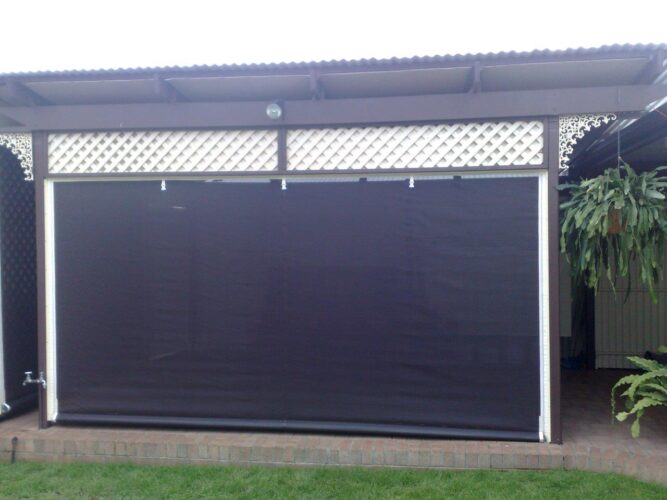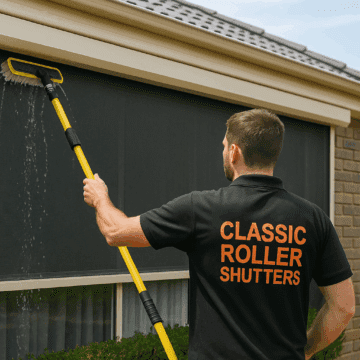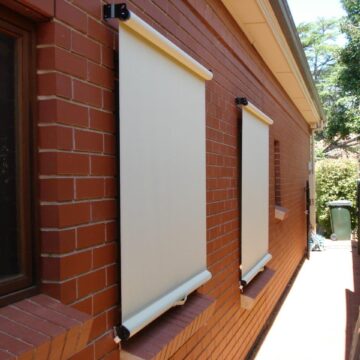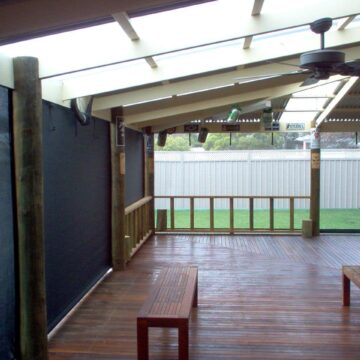Think the tear in your café blind means forking out for a whole new set? Not likely. Most outdoor blinds can be nursed back to health for a fraction of the replacement cost, even after a season of scorching northerlies or a Glenelg sea-spray battering. This guide shows how to spot what’s really wrong, choose the smart fix and keep cash in your pocket.
Inside you’ll find plain-English checklists for diagnosing cords, zips, fabric and motors; a no-nonsense run-down of typical Adelaide call-out fees, labour rates and parts prices; DIY walkthroughs that stop short of the dangerous stuff; and tips for finding a licenced technician when ladders or electrics enter the mix. We’ll also cover maintenance habits that shrug off UV, dust and coastal wind so your blinds last longer than our next heatwave. Read on, grab your tape-measure, and turn small problems into quick wins.
Step 1 – Diagnose the Problem: What’s Actually Wrong?
Before you race out for parts or call a trades-person, spend ten focused minutes checking the blind itself. A clear diagnosis stops you buying the wrong kit, paying double call-outs, or worse, replacing an entire system when a $20 clip would have done the trick. Adelaide’s fine red dust, salty gulf breezes and 40 °C pulses all leave distinctive fingerprints on outdoor blinds, so look for these usual suspects:
- Slipped or frayed lift cords/straps
- Rollers or side-tracks jammed with sand, dust or pet hair
- Torn, UV-brittled or mould-spotted PVC or fabric panels
- Mis-aligned Ziptrak or Zipscreen zips catching half-way down
- Storm-bent bottom rails, cracked clips or loosened brackets
Safety first—damage often hides sharp edges and live wiring:
- Turn off mains or battery power to any motor.
- Have a second person support wide café blinds while you inspect.
- Gloves and safety glasses protect against frayed wires and whipping straps.
Quick “should I drop everything?” checklist:
- Blind will not raise or lower at all → urgent, prevent further strain.
- Small tear under 50 mm or minor colour fade → note it, repair soon.
- Motor humming but tube not turning → disconnect immediately to avoid burnout.
Visual and Functional Tests
Gently lower and raise the blind, feeling for sticky spots and listening for grinding. At night, shine a torch from behind; pinholes and hairline tears glow like stars. Run a builder’s level across the head-box—if it’s tilting even a few millimetres, side tension will keep shredding zips.
Recording Damage for Quotes
Snap clear photos, measure width and drop to the nearest millimetre, and jot down the brand or model stamped on the pelmet. After a wild southerly, these notes back up storm insurance claims. Having precise details ready also helps Adelaide repairers price parts on the spot, saving you a second trip fee.
Step 2 – Repair or Replace? Making the Smart Call
Outdoor blinds aren’t single-use items; most of the time they just need a fresh panel, new zip or a re-tensioned spring, not a total rip-out. Before you green-light any quote, weigh up the numbers against the expected lifespan of the material in our hot, windy South-Australian climate:
- PVC café blinds: 7 years
- Acrylic canvas awnings: 8–10 years
- Mesh/privacy screens: 10 years+
If your blind is still within those ranges, chances are a repair buys you several more summers for far less cash.
| Blind Type | Typical Minor Repair (cord/zip/panel, incl. labour) | Full Replacement (incl. disposal) |
|---|---|---|
| PVC Café Blind | $120–$250 | $650–$900 |
| Acrylic Canvas Awning | $180–$300 | $750–$1,100 |
| Mesh/Privacy Screen | $160–$280 | $800–$1,200 |
Use the 40 percent rule: if the repair quote stays below 0.40 × replacement cost, fix it. Also look at surface condition—if more than 30 percent of the fabric is faded, chalky or brittle, replacement may be smarter.
Repairing instead of dumping keeps aluminium tubes and motors out of landfill, supports local parts suppliers and saves the energy tied up in making new fabric—wins all round.
Hidden Costs of Replacing
Even when the sticker price looks similar, full replacement drags in extras:
- Council hard-waste collection or skip hire
- Repainting or patching old bracket holes
- Multiple site visits that mean time off work
Add those and replacement often blows past the repair option.
When Replacement Beats Repair
Choose new gear if any of these apply:
- Motors pre-1990 with asbestos insulation or no IP rating
- Corded systems that fail current child-safety rules
- Major façade renovation requiring different colour scheme
- Structural damage to headbox or tubes after a severe storm
In those scenarios, replacement protects both safety and street appeal while giving you a fresh warranty.
Step 3 – Adelaide Repair Cost Breakdown: What You’re Likely to Pay
How much will an outdoor blinds repair sting the wallet? In Adelaide, the answer hinges on the size of the blind, the height of the install and whether the technician has the right parts on-board. Still, there are some reliable ball-parks you can use to sanity-check any quote.
Expect a standard metropolitan call-out fee of $130–$180 (covers travel and the first 15–30 minutes on site). After that:
- Independent handyman or carpenter: $70–$95 per hour
- Specialist blind company with branded parts: $90–$120 per hour
Common replacement parts, GST included:
- Crank handle: $20–$35
- Ziptrak spline & zip pair: $45–$70
- PVC panel re-skin (per m²): $40–$55
- 12 V tubular motor: $160–$260
Below is a rough guide to total invoice amounts, assuming average suburban access and no electrics other than plugging in a test lead.
| Job Size | Example Scope | Labour (hrs) | Parts | Call-out | Total (inc GST) |
|---|---|---|---|---|---|
| Small | Re-thread cord & fit new crank | 0.5 | $30 | $90 | $155–$180 |
| Medium | Replace 3 m PVC panel & zip set | 1.5 | $210 | $90 | $330–$380 |
| Large | Swap motor, retension spring, service 2 blinds | 3 | $260 | $90 | $510–$600 |
Factors That Bump Up Costs
- Second-storey or steep block access requiring a 3 m ladder or scaffold hire
- Smart-home hubs, sun or wind sensors that need programming after repair
- Rural or coastal jobs more than 25 km from the CBD (about $1.50 per km travel surcharge)
Simple Ways to Save
- Book multiple blinds in the same visit – the call-out fee rarely changes.
- Supply generic consumables such as galvanised screws if you already have them.
- Schedule repairs May–August when installers are quieter and more open to a sharp price.
Understanding Warranties & Insurance
Repairs usually carry two warranties: one on parts (from the manufacturer) and one on labour (from the technician). The industry norm in Adelaide is 12 months on parts, 3–6 months on workmanship; anything less should raise eyebrows.
If your outdoor blinds were damaged by a hailstorm or a rogue patio heater, insurers expect:
- Date-stamped photos of the damage
- A written repair quote and, once approved, a paid invoice
Keep those documents; many policies reimburse the call-out fee as well. Just check that the repairer’s ABN and licence number appear on the paperwork—claims departments reject hand-written receipts all the time.
Step 4 – DIY Outdoor Blind Repairs: Tools, Techniques and Safety
If you’re handy with a drill and don’t mind a bit of ladder work, plenty of outdoor blinds repair jobs can be knocked over in an afternoon. The golden rule: tackle only what you can do safely without special licences. Motors, hard-wired switches and anything that requires removing structural brackets belong to the pros. Everything else is fair game with the right kit, clear instructions and a dose of common sense.
Essential Tools & Consumables
Keep these staples in a labelled tub so you’re not hunting around mid-job:
- Flat and Phillips screwdrivers
- 4 mm HSS drill bits plus countersink
- 10 mm spanner or socket for Ziptrak bolts
- Heavy-duty scissors or rotary fabric cutter
12 G × 20 mmgalvanised hex-head screws (Adelaide favourite for aluminium frames)- Marine-grade, silicone-free spray lubricant
- Thread-locker for verandahs that vibrate in high wind
- Soft brush, microfibre cloths and isopropyl alcohol for cleaning
- PPE: cut-resistant gloves, safety glasses and a step-ladder rated to 120 kg
Tip: A small battery impact driver saves elbow grease when backing out rusty screws.
Quick Fixes You Can Do in Under 30 Minutes
- Re-thread a slipped crank cord
- Remove the valance cap to expose the drum.
- Feed cord through the eyelet, knot securely and add a dab of thread-locker.
- Wind the blind up and down twice to confirm even tension.
- Replace cracked end-caps on the bottom rail
- Pop the damaged cap with a flat screwdriver.
- Slide in the new cap, align drainage holes downward, tap home with a rubber mallet.
- Silence squeaky runners
- Wipe grit out of the side channels with a damp cloth.
- Spray a light film of marine lubricant, then operate the blind three times to spread.
Each of these fixes costs less than a pub lunch and instantly extends the life of the system.
Intermediate Repairs for the Weekend Handy-Person
- Realign a jammed Ziptrak blind
- Kill power if motorised.
- Remove the pelmet cover and loosen the two top-rail screws until the spring assembly rotates freely.
- Centre the fabric, re-tension one quarter-turn at a time, tighten screws, test.
- Patch a small PVC tear (< 50 mm)
- Clean both sides with isopropyl; let dry.
- Cut a rounded vinyl patch 20 mm larger than the tear, apply clear outdoor adhesive, press firmly and seam-roll.
- Swap out a sun-bleached canvas panel
- Unclip the spline, slide off the fabric sleeve, measure and cut the new panel, then reverse the process.
- Remember to match dye-lot numbers so the colour sits right under SA’s harsh UV.
Allow half a day, a helper for large spans and be patient—rushing fabric work leads to wrinkles that catch the wind.
When DIY Turns Dangerous or False-Economy
- Any blind wider than 4 m that needs two-person lifting
- Rusted or seized brackets anchored into brickwork (risk of masonry damage)
- Mains-powered motors or wiring—requires a licensed electrician under SA regulations
- Structural headboxes bent during a storm; hidden stress fractures can cause collapse
If you hit one of these roadblocks, down tools and call a qualified technician. Paying for expert help is cheaper than an emergency room visit—or replacing an entire blind because a $25 part was fitted incorrectly.
Step 5 – Finding Quality Parts & Repair Kits in Adelaide
Sourcing the right bit of hardware can make or break an outdoor blinds repair. Luckily, Adelaide has plenty of options, from big-box to boutique. The trick is knowing where each shines.
- Bunnings Warehouse – cheap, open late and good for generic screws, spray lubricant and PVC patch kits, but you’ll rarely find brand-specific Ziptrak zips or Acmeda gears.
- Specialist blind parts stores (Blind Repair Centre, Stanbond SA, etc.) – carry genuine Ziptrak, Zipscreen and Rollease Acmeda components and will usually match samples on the counter. We can order them in for you if you come in with the part or email us a picture.
- Manufacturer factory outlets – ideal when your blind model has been discontinued; they often have end-of-line fascias and colour-matched bottom rails stacked out back.
- Online suppliers with same-day metro couriers – handy for rural or after-hours orders; check freight is capped, not per item.
When choosing parts, confirm the aluminium tube diameter (most are 60 mm; heavier commercial units run 78 mm) and note the COLORBOND® code on your pelmet—Surfmist and Woodland Grey are easy to mix up in morning light. Special-order zips or fabrics generally land in 5–10 business days, longer in December.
Genuine parts usually give themselves away: crisp moulded logos, stainless-steel screws and plastics that feel waxy rather than brittle. If the price seems too good or the zip teeth look chalky, it’s probably an aftermarket knock-off that will fade before next footy season.
Price Guide for Popular Spare Parts
| Part | Average Retail Price |
|---|---|
| Ziptrak side spline (per side) | $22–$30 |
| PVC patch kit (100 × 150 mm) | $15–$20 |
| Crank gearbox assembly | $38–$55 |
| 60 mm aluminium top tube | $35–$45 |
| Mesh fabric (per linear metre, 3 m drop) | $40–$50 |
| Bottom rail end-cap pair | $8–$12 |
Environmental Disposal of Old Parts
Don’t dump scrap in the red bin. Aluminium tubes and brackets can be traded at most metal recyclers for a few dollars a kilo. PVC panels can be up-cycled as greenhouse sheeting or dropped at the NAWMA resource recovery centre, while failed motors should head to your council’s e-waste depot: the copper windings are recyclable and the gear oil is captured safely. A little sorting keeps heavy metals out of landfill and leaves you with a cleaner conscience—and workshop.
Step 6 – Hiring a Professional Outdoor Blind Repairer in Adelaide
DIY is fine until mains power, tall ladders or big-dollar fabric is on the line. At that point a qualified Adelaide repairer is worth every cent: they arrive with the right tools, carry public-liability cover and can stamp the invoice with a workmanship warranty you can wave at insurers later. Use the checklist below to choose a tradie who fixes the problem—rather than creating a new one.
How to Vet Technicians
- Look up their ABN and verify an SA contractor licence is current.
- Ask for proof of public liability insurance (minimum $10 million is industry norm).
- Scroll their Google or Facebook photos for before-and-after shots of similar blinds—Ziptrak repairs are a niche skill.
- Check whether they’re factory-authorised by your blind’s brand; that keeps your original warranty intact.
Questions to Ask Before Accepting a Quote
- Is the inspection or call-out fee credited against the repair if I go ahead?
- Do you keep common parts in the van, or will a second visit be needed?
- What warranty applies to parts and to labour? (Look for 12 months / 6 months.)
- Have you repaired my blind model before, including motorised versions?
- Will you remove and recycle old fabric and hardware?
Comparing Quotes & Negotiating
- Get at least three written quotes that break out labour, parts, GST and travel.
- Clarify disposal or scaffold hire—hidden line items that balloon final costs.
- If you have multiple blinds, bundle them; many technicians drop the call-out fee on the second unit.
What to Expect on Repair Day
Most crews provide a 45- to 90-minute arrival window. Clear furniture from the work zone and keep pets inside—riveters and impact drivers are loud. A competent tech will:
- Run the blind through full cycles before and after repair.
- Photograph completed work for your records.
- Hand over a paid invoice and warranty card before leaving.
Relax, sign off, and let the pros shoulder the wind-load test.
Step 7 – Maintain & Protect: Keeping Your Outdoor Blinds Trouble-Free
Regular TLC is the cheapest “repair” you’ll ever pay for. A few minutes each month keeps cords supple, zips sliding and motors humming while sparing you yet another call-out fee. Adelaide’s mix of baking summers, salty gulf air and gritty northerlies is tough on fabrics and hardware, so prevention is king.
After any maintenance session, cycle the blind up and down twice to spread lubricant and spot issues early.
Monthly Five-Minute Routine
- Hose the fabric with cool water; add a soft brush around the hem bar to lift red dust.
- Wipe side tracks with a damp microfibre cloth, then mist a silicone-free marine lubricant.
- Check cords or straps for fluffing; trim loose fibres before they snag.
Seasonal Checklist
Spring
- Inspect zips, seams and spline for UV cracks.
- Touch-up paint chips on brackets to stop rust.
Autumn
- Re-lubricate tracks before winter rain sets in.
- Tighten mounting screws; verandahs shrink and swell over summer.
Summer & Winter
- Clean salt spray monthly if you live west of Tapleys Hill Road.
- Swap rechargeable batteries in 12 V motors every second winter to avoid low-power strain.
Day-to-Day Operating Tips
- Always tension the blind before locking bottom latches; slack fabric whips and tears.
- Avoid rolling wet PVC—let it dry first to stop mould rings.
- Retract halfway during moderate winds rather than leaving it fully down and flapping.
Storm Prep & Smart Upgrades
When a front barrels in off Gulf St Vincent, retract the blinds fully, clip hold-down straps tight and switch motors off at the isolator. Consider fitting:
- Wind sensors that auto-retract above 40 km/h
- UV-blocking protectant sprays every two years for PVC and mesh
A small spend on maintenance today beats an outdoor blinds repair bill tomorrow, and keeps your patio looking sharp through every South Australian season.
Step 8 – Straight Answers to Common Outdoor Blind Repair Questions
Below is a rapid-fire Q&A distilled from the calls we field every week. Use it as a sanity check before you pull the ladder out—or pull your wallet out.
Is it worth repairing blinds?
Yes, provided the quote stays under 40 % of replacement value and the fabric is still structurally sound. A $180 service call that resets cords beats an $800 rip-and-replace every time.
Can patio or vertical blinds be fixed?
Usually. Carrier clips, chains, bottom weights and cords are all plug-and-play parts that cost peanuts. If the vanes themselves are stained or warped, swap them in packs rather than ditching the track.
Do Bunnings install outdoor blinds?
They do. The “Made-to-Measure” service covers supply and installation, but the range is limited and installers may not tackle brand-specific issues like Ziptrak zipper alignment.
How do I get a Ziptrak blind back on track?
Lower the blind halfway, guide the spline into the side channel, then raise and lower slowly. If teeth are frayed or the fabric still wanders, replace the spline set—about $50.
Where can I find outdoor blind repair near me?
Search “outdoor blinds repair + Adelaide + [suburb]” and shortlist providers with a Google rating above 4.5. Always confirm they’re licensed and carry parts for your blind brand.
What comes in a typical outdoor blind repair kit?
Expect replacement cords or splines, end-caps, hex screws, a Torx or Allen key, PVC patch squares and a mini tube of UV-safe adhesive—enough to fix the common niggles in one session.
Next Steps
Outdoor blind giving you grief? You now have a game plan:
- Diagnose the fault before spending a cent.
- Compare repair cost against the 40 % rule and fabric age.
- Use our Adelaide price cheatsheet to sanity-check any quote.
- Decide whether it’s a 30-minute DIY tweak or a job for a licensed tech.
- Lock in a simple maintenance routine so problems don’t sneak back.
Tick those boxes and you’ll squeeze extra years out of every crank, zip and panel—without emptying the renovation fund.
Ready for professional backup? Book a free on-site assessment with the local team who build, service and repair blinds every day. We’ll arrive with the right parts, give you a transparent fixed price and be gone before the kettle boils. Reach out to Classic Roller Shutters Adelaide and get your outdoor space summer-ready, fast.




